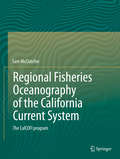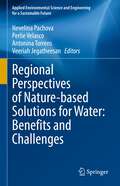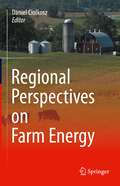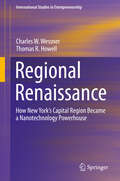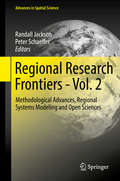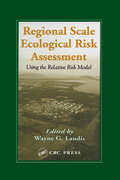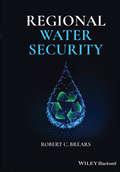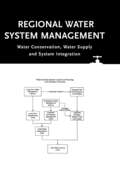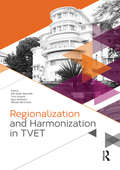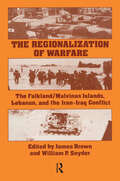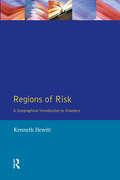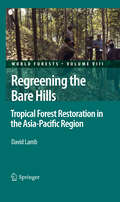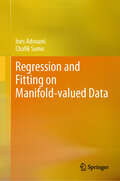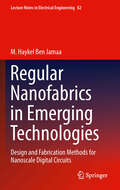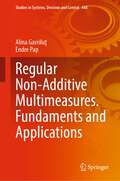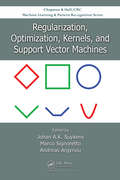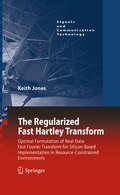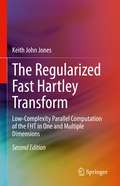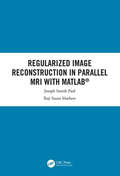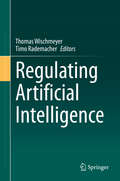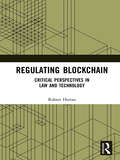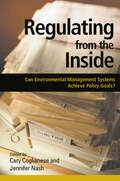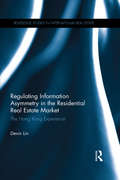- Table View
- List View
Regional Fisheries Oceanography of the California Current System
by Sam McclatchieThe California Current System is one of the best studied ocean regions of the world, and the level of oceanographic information available is perhaps only surpassed by the northeast and northwest Atlantic The current literature (later than 1993) offers no comprehensive, integrated review of the regional fisheries oceanography of the California Current System. This volume summarizes information of more than 60-year California Cooperative Oceanic Fisheries Investigation (CalCOFI) While providing a large bibliography, the intent was to extract themes relevant to current research rather than to prepare a compendious review of the literature The work presents a useful review and reference point for multidisciplinary fisheries scientists and biological oceanographers new to working in the California Current System, and to specialists wishing to access information outside their core areas of expertise. In addition it aims to deliver an up to date reference to the current state of knowledge of fisheries oceanography in the California Current System.
Regional Perspectives of Nature-based Solutions for Water: Benefits and Challenges (Applied Environmental Science and Engineering for a Sustainable Future)
by Nevelina Pachova Perlie Velasco Antonina Torrens Veeriah JegatheesanNature-based solutions (NbS) are solutions inspired or supported by nature. They include ecosystem conservation and restoration measures, as well as the creation or enhancement of natural processes in man-made ecosystems, such as cities. Recent interest in NbS has emphasized their importance for urban water management and cities across the world have begun to experiment with them. Experiences from different contexts, however, are not adequately captured and understood. This book aims to address this gap by compiling case studies and reviews that explore NbS for urban water management from different regions and perspectives and highlight emerging challenges and opportunities for harnessing their potential.
Regional Perspectives on Farm Energy
by Daniel CiolkoszThis book examines the characteristics and opportunities for farm energy in the northeast quadrant of the United States, with attention to energy use, strategic energy management, and energy production by solar, wind, biomass, and other means. Throughout, the distinct characteristics of the region and their impact on energy solutions are discussed, and the outlook for future energy strategies is considered. Farm energy production and use are topics of increasing interest, as the need for improved efficiency and the opportunity for sustainable energy production both drive agricultural enterprises to reduce energy use and pursue opportunities for renewable energy production and use on the farm. However, the unique regional characteristics of agriculture make it challenging to apply a single approach to all situations.
Regional Renaissance: How New York’s Capital Region Became a Nanotechnology Powerhouse (International Studies in Entrepreneurship #42)
by Charles W. Wessner Thomas R. HowellThis book examines ways in which formerly prosperous regions can renew their economy during and after a period of industrial and economic recession. Using New York’s Capital Region (i.e., Albany, Troy, Schenectady, etc.) as a case study, the authors show how entrepreneurship, innovation, investment in education, research and political collaboration are critical to achieving regional success. In this way, the book provides other regions and nations with a real-life model for successful economic development. In the past half century, the United States and other nations have seen an economic decline of formerly prosperous regions as a result of new technology and globalization. One of the hardest-hit United States regions is Upstate New York or “the Capital Region”; it experienced a demoralizing hemorrhage of manufacturing companies, jobs and people to other regions and countries. To combat this, the region, with the help of state leaders, mounted a decades-long effort to renew and restore the region’s economy with a particular focus on nanotechnology. As a result, New York’s Capital Region successfully added thousands of well-paying, skill-intensive manufacturing jobs. New York’s success story serves as a model for economic development for policy makers that includes major public investments in educational institutions and research infrastructure; partnerships between academia, industry and government; and creation of frameworks for intra-regional collaboration by business, government, and academic actors. Featuring recommendations for best practices in regional development policy, this book is appropriate for scholars, students, researchers and policy makers in regional development, innovation, R&D policy, economic development and economic growth.
Regional Research Frontiers - Vol. 2
by Randall Jackson Peter SchaefferThis is the second volume in a two-part series on frontiers in regional research. It identifies methodological advances as well as trends and future developments in regional systems modelling and open science. Building on recent methodological and modelling advances, as well as on extensive policy-analysis experience, top international regional scientists identify and evaluate emerging new conceptual and methodological trends and directions in regional research. Topics such as dynamic interindustry modelling, computable general equilibrium models, exploratory spatial data analysis, geographic information science, spatial econometrics and other advanced methods are the central focus of this book. The volume provides insights into the latest developments in object orientation, open source, and workflow systems, all in support of open science. It will appeal to a wide readership, from regional scientists and economists to geographers, quantitatively oriented regional planners and other related disciplines. It offers a source of relevant information for academic researchers and policy analysts in government, and is also suitable for advanced teaching courses on regional and spatial science, economics and political science.
Regional Satellite Oceanography
by Serge VictorovThis work addresses the whole range of problems relating to the application of satellite technology to studies of regional seas and sea phenomona - the Gulf Stream, the Kuroshia Current - and coastal zones. It argues that to emphasize global applications is to fail to take into account fundamental idiosyncracies specific to the regional perspective
Regional Scale Ecological Risk Assessment: Using the Relative Risk Model
by Wayne G. LandisAs debates over how relative risk can be used to shape landscape-scale environmental management intensify, Regional-Scale Risk Assessment demonstrates the capabilities of RRM using nine case studies in the Pacific Northwest, Pennsylvania, Brazil, and Tasmania. The authors use a process of ranking and filters to interrelate different kinds of risks
Regional Water Security
by Robert C. BrearsRegional Water Security provides new research on policy innovations that promote the application of demand management and green infrastructure (GI) in managing water resources across regions sustainably. In particular, with regional water security around the world at risk from climatic and non-climatic challenges impacting water quantity and water quality, this book, in addition to providing examples of demand management and GI being implemented in various locations globally, contains in-depth case studies that illustrate how regions, of differing climates, lifestyles, and income levels, have implemented policy innovations that promote the application of demand management and GI to achieve regional water security for humans while protecting and restoring the natural environment. Regional Water Security will be of interest to regional water resource managers, town and regional planners, resource conservation managers, policymakers, international companies, and organizations as well as environmental NGOs, researchers, and graduate and undergraduate students.
Regional Water System Management: Water Conservation, Water Supply and System Integration
by Enrique CabreraThe spectacular industrial and economic development of the twentieth century was achieved at a considerable environmental cost. The increasingly precarious position of water, the most valuable of natural resources, reflects this trend. Today we have come to realise that concepts of sustainable development need to
Regionalization and Harmonization in TVET: Proceedings of the 4th UPI International Conference on Technical and Vocational Education and Training (TVET 2016), November 15-16, 2016, Bandung, Indonesia
by Ade Gafar Abdullah, Tutin Aryanti, Agus Setiawan & Maizam Binti AliasRegionalization and Harmonization in TVET contains the papers presented at the 4th UPI International Conference on Technical and Vocational Education and Training (TVET 2016, Bandung, Indonesia, 15-16 November 2016). 1. Standardization in Regionalization and Harmonization2. Skill and Personal Development3. Social and Cultural Issues4. Teaching Innovations in TVET5. Innovations in Engineering and Education.
The Regionalization of Warfare: The Falkland/Malvinas Islands, Lebanon, and the Iran-Iraq Conflict
by James Brown William P. SnyderThree wars have dominated world events in recent years: The conflict which erupted between the United Kingdom and Argentina over the Falkland/Malvinas Islands; the multinational conflict in Lebanon involving Irsaeli, Syrian, and FLO forces in Lebanon; and the savage struggles between ground and air units of the Iranian and Iraqi forces. The scale and intensity of these wars, their potential for global conflict, make them crucial for an understanding among citizens in general, and defense and political analysts in particular.The authors and contributors to this most unusual volume come to several common conclusions: professionalism is a crucial factor in military effectiveness, but not necessarily dependent on modes of recruitment; high technology is crucial, but only in relation to the quality and training of the personnel; public support is necessary to sustain military morale in democratic and authoritarian regimes alike. These are only some of the incisive findings registered and explored in The Regionalization of Warfare.The volume a'ssembles experts not only on these three major regional and interregional conflicts, but on current U.S. defense policies; Soviet strategic interests in Middle East and Persian Gulf conflicts; and a series of papers on lessons learned and unlearned as a result of these "small wars" of the early 1980s. For those interested in military history, global strategy, and regional rivalries, this -collection of finely written, sophisticated papers will prove to be of intense concern.
Regions of Risk: A Geographical Introduction to Disasters (Themes In Resource Management)
by Kenneth HewittAn introduction to hazards, human vulnerability and disaster, paying particular attention to the more severe or novel risks and disaster that affect the general public. The book is split into two parts, the first of which gives an overview of the field of risk and disaster in terms of three perspectives: hazards perspective; vulnerability perspective and the active perspective. The second part illustrates and develops these ideas in relation to some of the more severe dangers and disasters of the twentieth century, for example, earthquake risk, cities at risk and the civil disasters of war.
Regreening the Bare Hills
by David LambIn Regreening the Bare Hills: Tropical Forest Restoration in the Asia-Pacific Region, David Lamb explores how reforestation might be carried out both to conserve biological diversity and to improve the livelihoods of the rural poor. While both issues have attracted considerable attention in recent years, this book takes a significant step, by integrating ecological and silvicultural knowledge within the context of the social and economic issues that can determine the success or failure of tropical forest landscape restoration. Describing new approaches to the reforestation of degraded lands in the Asia-Pacific tropics, the book reviews current approaches to reforestation throughout the region, paying particular attention to those which incorporate native species - including in multi-species plantations. It presents case studies from across the Asia-Pacific region and discusses how the silvicultural methods needed to manage these 'new' plantations will differ from conventional methods. It also explores how reforestation might be made more attractive to smallholders and how trade-offs between production and conservation are most easily made at a landscape scale. The book concludes with a discussion of how future forest restoration may be affected by some current ecological and socio-economic trends now underway. The book represents a valuable resource for reforestation managers and policy makers wishing to promote these new silvicultural approaches, as well as for conservationists, development experts and researchers with an interest in forest restoration. Combining a theoretical-research perspective with practical aspects of restoration, the book will be equally valuable to practitioners and academics, while the lessons drawn from these discussions will have relevance elsewhere throughout the tropics.
Regression and Fitting on Manifold-valued Data
by Ines Adouani Chafik SamirThis book introduces in a constructive manner a general framework for regression and fitting methods for many applications and tasks involving data on manifolds. The methodology has important and varied applications in machine learning, medicine, robotics, biology, computer vision, human biometrics, nanomanufacturing, signal processing, and image analysis, etc. The first chapter gives motivation examples, a wide range of applications, raised challenges, raised challenges, and some concerns. The second chapter gives a comprehensive exploration and step-by-step illustrations for Euclidean cases. Another dedicated chapter covers the geometric tools needed for each manifold and provides expressions and key notions for any application for manifold-valued data. All loss functions and optimization methods are given as algorithms and can be easily implemented. In particular, many popular manifolds are considered with derived and specific formulations. The same philosophy is used in all chapters and all novelties are illustrated with intuitive examples. Additionally, each chapter includes simulations and experiments on real-world problems for understanding and potential extensions for a wide range of applications.
Regular Nanofabrics in Emerging Technologies
by M. Haykel Ben JamaaRegular Nanofabrics in Emerging Technologies gives a deep insight into both fabrication and design aspects of emerging semiconductor technologies, that represent potential candidates for the post-CMOS era. Its approach is unique, across different fields, and it offers a synergetic view for a public of different communities ranging from technologists, to circuit designers, and computer scientists. The book presents two technologies as potential candidates for future semiconductor devices and systems and it shows how fabrication issues can be addressed at the design level and vice versa. The reader either for academic or research purposes will find novel material that is explained carefully for both experts and non-initiated readers. Regular Nanofabrics in Emerging Technologies is a survey of post-CMOS technologies. It explains processing, circuit and system level design for people with various backgrounds.
Regular Non-Additive Multimeasures. Fundaments and Applications (Studies in Systems, Decision and Control #448)
by Alina Gavriluţ Endre PapThis book is intended to be an exhaustive study on regularity and other properties of continuity for different types of non-additive multimeasures and with respect to different types of topologies. The book is addressed to graduate and postgraduate students, teachers and all researchers in mathematics, but not only. Since the notions and results offered by this book are closely related to various notions of the theory of probability, this book will be useful to a wider category of readers, using multivalued analysis techniques in areas such as control theory and optimization, economic mathematics, game theory, decision theory, etc. Measure and integration theory developed during the early years of the 20th century is one of the most important contributions to modern mathematical analysis, with important applications in many fields. In the last years, many classical problems from measure theory have been treated in the non-additive case and also extended in the set-valued case. The property of regularity is involved in many results of mathematical analysis, due to its applications in probability theory, stochastic processes, optimal control problems, dynamical systems, Markov chains, potential theory etc.
Regularization and Bayesian Methods for Inverse Problems in Signal and Image Processing
by Jean-Fran?ois Giovannelli Jér Me IdierThe focus of this book is on "ill-posed inverse problems". These problems cannot be solved only on the basis of observed data. The building of solutions involves the recognition of other pieces of a priori information. These solutions are then specific to the pieces of information taken into account. Clarifying and taking these pieces of information into account is necessary for grasping the domain of validity and the field of application for the solutions built. For too long, the interest in these problems has remained very limited in the signal-image community. However, the community has since recognized that these matters are more interesting and they have become the subject of much greater enthusiasm. From the application field's point of view, a significant part of the book is devoted to conventional subjects in the field of inversion: biological and medical imaging, astronomy, non-destructive evaluation, processing of video sequences, target tracking, sensor networks and digital communications. The variety of chapters is also clear, when we examine the acquisition modalities at stake: conventional modalities, such as tomography and NMR, visible or infrared optical imaging, or more recent modalities such as atomic force imaging and polarized light imaging.
Regularization, Optimization, Kernels, and Support Vector Machines (Chapman & Hall/CRC Machine Learning & Pattern Recognition)
by Johan A. K. Suykens Marco Signoretto Andreas ArgyriouRegularization, Optimization, Kernels, and Support Vector Machines offers a snapshot of the current state of the art of large-scale machine learning, providing a single multidisciplinary source for the latest research and advances in regularization, sparsity, compressed sensing, convex and large-scale optimization, kernel methods, and support vecto
The Regularized Fast Hartley Transform
by Keith JonesThe Regularized Fast Hartley Transform provides the reader with the tools necessary to both understand the proposed new formulation and to implement simple design variations that offer clear implementational advantages, both practical and theoretical, over more conventional complex-data solutions to the problem. The highly-parallel formulation described is shown to lead to scalable and device-independent solutions to the latency-constrained version of the problem which are able to optimize the use of the available silicon resources, and thus to maximize the achievable computational density, thereby making the solution a genuine advance in the design and implementation of high-performance parallel FFT algorithms.
The Regularized Fast Hartley Transform: Low-Complexity Parallel Computation of the FHT in One and Multiple Dimensions
by Keith John JonesThis book describes how a key signal/image processing algorithm – that of the fast Hartley transform (FHT) or, via a simple conversion routine between their outputs, of the real‑data version of the ubiquitous fast Fourier transform (FFT) – might best be formulated to facilitate computationally-efficient solutions. The author discusses this for both 1-D (such as required, for example, for the spectrum analysis of audio signals) and m‑D (such as required, for example, for the compression of noisy 2-D images or the watermarking of 3-D video signals) cases, but requiring few computing resources (i.e. low arithmetic/memory/power requirements, etc.). This is particularly relevant for those application areas, such as mobile communications, where the available silicon resources (as well as the battery-life) are expected to be limited. The aim of this monograph, where silicon‑based computing technology and a resource‑constrained environment is assumed and the data is real-valued in nature, has thus been to seek solutions that best match the actual problem needing to be solved.
Regularized Image Reconstruction in Parallel MRI with MATLAB
by Joseph Suresh Paul Raji Susan MathewRegularization becomes an integral part of the reconstruction process in accelerated parallel magnetic resonance imaging (pMRI) due to the need for utilizing the most discriminative information in the form of parsimonious models to generate high quality images with reduced noise and artifacts. Apart from providing a detailed overview and implementation details of various pMRI reconstruction methods, Regularized image reconstruction in parallel MRI with MATLAB examples interprets regularized image reconstruction in pMRI as a means to effectively control the balance between two specific types of error signals to either improve the accuracy in estimation of missing samples, or speed up the estimation process. The first type corresponds to the modeling error between acquired and their estimated values. The second type arises due to the perturbation of k-space values in autocalibration methods or sparse approximation in the compressed sensing based reconstruction model. Features: Provides details for optimizing regularization parameters in each type of reconstruction. Presents comparison of regularization approaches for each type of pMRI reconstruction. Includes discussion of case studies using clinically acquired data. MATLAB codes are provided for each reconstruction type. Contains method-wise description of adapting regularization to optimize speed and accuracy. This book serves as a reference material for researchers and students involved in development of pMRI reconstruction methods. Industry practitioners concerned with how to apply regularization in pMRI reconstruction will find this book most useful.
Regulating Artificial Intelligence
by Thomas Wischmeyer Timo RademacherThis book assesses the normative and practical challenges for artificial intelligence (AI) regulation, offers comprehensive information on the laws that currently shape or restrict the design or use of AI, and develops policy recommendations for those areas in which regulation is most urgently needed. By gathering contributions from scholars who are experts in their respective fields of legal research, it demonstrates that AI regulation is not a specialized sub-discipline, but affects the entire legal system and thus concerns all lawyers. Machine learning-based technology, which lies at the heart of what is commonly referred to as AI, is increasingly being employed to make policy and business decisions with broad social impacts, and therefore runs the risk of causing wide-scale damage. At the same time, AI technology is becoming more and more complex and difficult to understand, making it harder to determine whether or not it is being used in accordance with the law. In light of this situation, even tech enthusiasts are calling for stricter regulation of AI. Legislators, too, are stepping in and have begun to pass AI laws, including the prohibition of automated decision-making systems in Article 22 of the General Data Protection Regulation, the New York City AI transparency bill, and the 2017 amendments to the German Cartel Act and German Administrative Procedure Act. While the belief that something needs to be done is widely shared, there is far less clarity about what exactly can or should be done, or what effective regulation might look like. The book is divided into two major parts, the first of which focuses on features common to most AI systems, and explores how they relate to the legal framework for data-driven technologies, which already exists in the form of (national and supra-national) constitutional law, EU data protection and competition law, and anti-discrimination law. In the second part, the book examines in detail a number of relevant sectors in which AI is increasingly shaping decision-making processes, ranging from the notorious social media and the legal, financial and healthcare industries, to fields like law enforcement and tax law, in which we can observe how regulation by AI is becoming a reality.
Regulating Blockchain: Critical Perspectives in Law and Technology
by Robert HerianAs the distributed architecture underpinning the initial Bitcoin anarcho-capitalist, libertarian project, 'blockchain' entered wider public imagination and vocabulary only very recently. Yet in a short space of time it has become more mainstream and synonymous with a spectacular variety of commercial and civic 'problem'/'solution' concepts and ideals. From commodity provenance, to electoral fraud prevention, to a wholesale decentralisation of power and the banishing of the exploitative practices of 'middlemen', blockchain stakeholders are nothing short of evangelical in their belief that it is a force for good. For these reasons and more the technology has captured the attention of entrepreneurs, venture capitalists, global corporations and governments the world over. Blockchain may indeed offer a unique technical opportunity to change cultures of transparency and trust within cyberspace, and as ‘revolutionary’ and ‘disruptive’ has the potential to shift global socioeconomic and political conventions. But as a yet largely unregulated, solutionist-driven phenomenon, blockchain exists squarely within the boundaries of capitalist logic and reason, fast becoming central to the business models of many sources of financial and political power the technology was specifically designed to undo, and increasingly allied to neoliberal strategies with scant regard for collective, political or democratic accountability in the public interest. Regulating Blockchain casts a critical eye over the technology, its ‘ecosystem’ of stakeholders, and offers a challenge to the prevailing discourse proclaiming it to be the great techno-social enabler of our times.
Regulating from the Inside: Can Environmental Management Systems Achieve Policy Goals (Rff Press Ser.)
by Cary CoglianeseEnvironmental Management Systems (EMSs) offer an approach to regulatory policy that lies somewhere between free-market and traditional command-and-control methods. Worldwide, hundreds of thousands of private firms have adopted or are considering adopting these internally managed systems for improving environmental performance. In the United States, the Environmental Protection Agency has established a special recognition for firms that adopt EMSs. Already, numerous state agencies have proposed or adopted 'green-tier systems' that allow firms with EMSs to be exempted from otherwise applicable requirements. Yet while private- and public-sector interest in EMSs is booming, limited empirical evidence is available about the efficacy of EMSs. To close the gap between advocacy and analysis, Regulating from the Inside brings together cutting-edge work of leading scholars, providing the most comprehensive analysis to date of environmental management systems. Intended to frame the future policy and the research agenda about EMSs, the discussions are organized around two critical questions: How have EMSs worked in firms that have already adopted them? What potential and limitations do they have as policy tools in the future? Addressing the arguments of both advocates and skeptics, the chapters examine why firms adopt EMSs; how firms implement EMSs; how EMSs answer concerns about fairness, corporate social responsibility, and sustainability; and what kind of impact EMSs may have on the global economy.
Regulating Information Asymmetry in the Residential Real Estate Market: The Hong Kong Experience (Routledge Studies in International Real Estate)
by Devin LinThis book conducts a detailed examination of the current form of the Hong Kong residential property regulatory system: the 2013 Residential Properties (Firsthand Sales) Ordinance (Cap 621). The author sheds light on how the new legislation promotes a number of values including information symmetry, consumer protection, the free market and business efficacy. It provides a detailed account of how the regulatory mechanism has evolved over the past three decades to catch unconsscionable sales tactics (such as selective information and/or misrepresentation of location, size, completion date and past transactions) and monitor sales practices in order to protect the interests of stakeholders in this ever-changing first-hand residential property market. This book breaks down this complicated subject matter by focusing a number of chapters each on a specific attribute of the residential property on sale. It then examines the various channels through which the information is communicated to the prospective buyer and discusses misrepresentation of the key information in sales of residential properties as criminal liability.The tension between consumer’s rights on one hand and the pursuit of free market principles on the other is but one example of the conflicting values thoroughly discussed in the book, others include superstition vs. modernization and clarity vs. flexibility. Aimed at those with an interest in consumer protection and transparency-orientated legislation in commercialized real estate transactions, this book seeks to provide an in-depth discussion of the latest trends and directions of travel.
